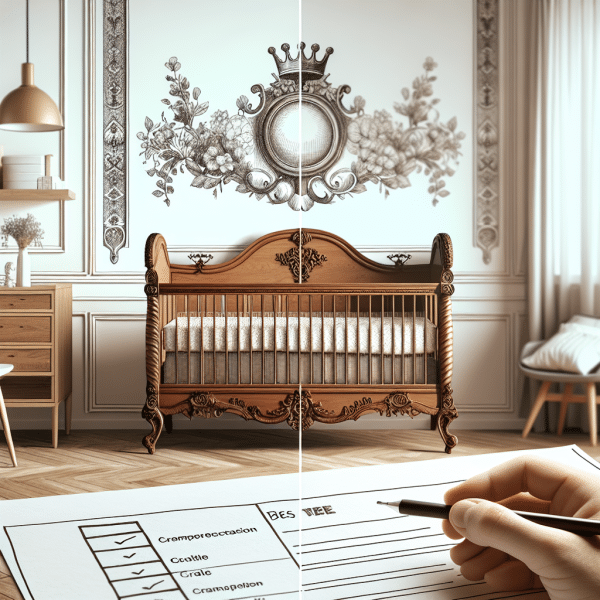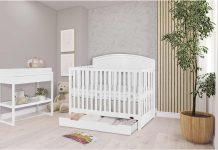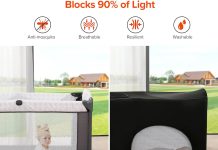So, you’ve stumbled upon a beautiful antique crib and you’re wondering if it’s safe for your little one. It’s a valid concern, as safety standards have significantly evolved over the years. In this article, we will guide you through the process of determining whether an antique crib meets modern safety standards, ensuring that your baby’s sleep space is both charming and secure.
Review contents
Overview
Antique cribs add a touch of nostalgia and charm to any nursery. However, when it comes to the safety of your precious little one, it is important to ensure that the crib meets modern safety standards. In this comprehensive article, we will guide you through the process of understanding antique cribs, assessing their safety, and using them securely. By following these guidelines, you can enjoy the beauty of an antique crib while keeping your baby safe.
Introduction
Antique cribs carry a certain allure with their classic design and intricate craftsmanship. However, as with any antique item, there are factors to consider before using them for your baby. Modern safety standards have evolved significantly over the years, and it is crucial to determine if an antique crib meets these standards to ensure the safety and well-being of your child. In this article, we will explore the definition and historical significance of antique cribs, discuss modern safety standards, and provide a step-by-step guide to assessing the safety of an antique crib. Additionally, we will offer tips on caring for and using antique cribs safely. Let’s embark on this journey to make sure your little one can sleep soundly in a beautiful and secure antique crib.
1. Understanding Antique Cribs
Antique cribs hold a special place in our hearts, symbolizing a connection to the past and a sense of nostalgia. These cribs are typically characterized by their intricate designs, unique materials, and meticulous craftsmanship. Understanding the characteristics and the historical significance of antique cribs is essential to properly assess their safety.
1.1 Definition and Characteristics
Antique cribs are cribs that were manufactured many years ago, often dating back several decades or even centuries. They are typically made from solid wood and exude a timeless elegance. These cribs often feature ornate carvings, intricate details, and unique design elements that set them apart from modern cribs. It is important to note that the age of an antique crib does not necessarily correlate with its safety standards, as safety regulations have evolved significantly over time.
1.2 Historical Significance
Antique cribs hold a historical significance that adds to their allure. They allow us to connect with the past, reflecting the design trends and craftsmanship of different eras. Many antique cribs have been passed down through generations, creating a sense of family history and tradition. However, it is crucial to remember that safety standards have changed over time, and what may have been considered safe in the past may not meet modern safety requirements.
2. Modern Safety Standards for Cribs
The safety of your baby is of utmost importance, and modern safety standards for cribs aim to minimize risks and ensure a secure sleeping environment. It is essential to familiarize yourself with these standards to evaluate the safety of an antique crib.
2.1 Consumer Product Safety Commission (CPSC) Regulations
The Consumer Product Safety Commission (CPSC) is an independent agency in the United States that sets safety standards for various consumer products, including cribs. CPSC regulations outline requirements related to crib design, construction, labeling, and warning labels. These regulations include guidelines for mattress fit, slat spacing, structural stability, and other key safety factors. When assessing the safety of an antique crib, it is important to ensure that it meets or exceeds the CPSC regulations applicable at the time it was manufactured.
2.2 Safety Standards for Cribs in Different Countries
Safety standards for cribs may vary from country to country. For instance, the European Union has its own set of safety standards known as the European Standard EN 716, which covers various aspects of crib safety. It is essential to be aware of the safety standards in your specific region or country to ensure that the antique crib meets the necessary requirements.
3. Assessing the Safety of an Antique Crib
Before using an antique crib, it is crucial to thoroughly assess its safety to ensure that it provides a secure sleeping environment for your baby. There are several steps you can take to evaluate the safety of an antique crib.
3.1 Check for Recalls and Safety Alerts
Before purchasing or using an antique crib, check for any recalls or safety alerts associated with the particular model or brand. The CPSC website provides a comprehensive list of crib recalls, and other regulatory bodies in different countries also offer similar resources. By checking for recalls and safety alerts, you can identify any potential hazards or issues with the crib that may compromise its safety.
3.2 Inspection for Hazardous Materials
Certain older cribs may have been painted with lead-based paint or finished with toxic materials. Inspect the crib for any signs of peeling or chipping paint, as well as the presence of lead or other harmful substances. If you suspect the presence of hazardous materials, it is best to consult a professional who can provide guidance on safe removal or remediation.
4. Structural Stability and Durability
The structural stability and durability of an antique crib are crucial factors in ensuring its safety. Assessing the bed frame and the mattress support system can help determine the overall stability and reliability of the crib.
4.1 Assessing the Bed Frame
Carefully examine the bed frame of the antique crib for any signs of damage, weakness, or instability. Look for loose joints, cracks, or splintering wood, as these can compromise the crib’s structural integrity. The bed frame should be sturdy and capable of supporting the weight of your baby without any signs of wobbling or sagging.
4.2 Evaluating the Mattress Support System
The mattress support system plays a vital role in the safety and comfort of the crib. Check if the mattress support system is intact and securely attached to the bed frame. Ensure that it provides adequate support and does not show signs of bending or warping. A stable and properly functioning mattress support system is essential for a safe sleeping environment.
5. Slat Spacing and Avoiding Entrapment Hazards
The spacing between the slats of the crib is an important consideration to prevent any potential entrapment hazards for your baby. Understanding the guidelines for slat spacing and testing for entrapment risks can help determine the safety of an antique crib.
5.1 Guidelines for Slat Spacing
Modern safety standards specify guidelines for the spacing between crib slats to prevent infants from getting their heads, limbs, or other body parts trapped between them. The recommended maximum distance between slats is typically 2-3/8 inches (about 6 centimeters). Measure the gap between the slats in the antique crib to ensure that it meets these guidelines.
5.2 Testing for Entrapment Risks
To test for potential entrapment risks, attempt to pass a soda can or a cardboard tube that is approximately the size of a baby’s head through the slats. If the object can pass through, it indicates a potential hazard, and the crib may not meet current safety standards. Ensuring that there are no entrapment risks is crucial for the safety of your baby.
6. Mattress Fit and Firmness
The fit and firmness of the mattress are important considerations for ensuring the safety and comfort of your baby. Assessing the mattress fit and determining the firmness can help ensure a secure sleeping surface.
6.1 Checking the Mattress Fit
A well-fitting mattress is essential to prevent any gaps between the mattress and the crib sides. These gaps can pose a risk of entrapment or suffocation for your baby. Measure the mattress and compare it to the dimensions of the crib to ensure a snug and secure fit.
6.2 Determining Mattress Firmness
The firmness of the mattress contributes to the safety and proper development of your baby. A mattress that is too soft may increase the risk of suffocation or Sudden Infant Death Syndrome (SIDS). Press your hand on the mattress surface to check for excessive softness. A firm mattress that maintains its shape and does not conform to your hand is considered ideal for infant sleep.
7. Final Steps for Ensuring Safety
After evaluating the overall safety of the antique crib, there are a few additional steps you can take to further ensure the safety of your baby.
7.1 Addressing Lead Paint and Toxic Finishes
If you find that the antique crib has lead-based paint or toxic finishes, it is important to take appropriate action. Consult a professional who can guide you on how to safely remove or remediate these hazardous materials. Ensure that the crib is free from any potential sources of toxicity to create a safe environment for your baby.
7.2 Replacing or Repairing Damaged Parts
If you identify any damaged parts during the assessment, consider replacing or repairing them to ensure the crib’s structural integrity. Contact a professional who specializes in antique furniture restoration to ensure that the repairs are done safely and effectively.
7.3 Seek Professional Inspection and Certification
To gain peace of mind and ensure the utmost safety for your baby, consider seeking a professional inspection and certification for the antique crib. Experts in crib safety can thoroughly examine the crib and provide a certification indicating that it meets modern safety standards. This certification will provide additional reassurance and validate the safety of the antique crib.
8. Caring for and Using Antique Cribs Safely
Once you have determined that the antique crib meets modern safety standards, it is important to care for and use it safely to provide a secure sleeping environment for your baby.
8.1 Maintenance and Cleaning
Regular maintenance and cleaning are essential for preserving the condition of the antique crib and ensuring its safety. Follow the manufacturer’s instructions, if available, for cleaning and maintaining the crib. Avoid using harsh chemical cleaners that may damage the wood or any delicate finishes. A gentle cleaning solution or mild soap and water should be sufficient for routine cleaning.
8.2 Follow Safe Sleep Practices
In addition to ensuring the safety of the crib itself, it is crucial to follow safe sleep practices recommended by experts to create a secure sleeping environment for your baby. These practices include placing the baby on their back to sleep, avoiding loose bedding or soft objects in the crib, and keeping the crib free from any hazards or potential entrapment risks. Consistently following these practices will help ensure a safe and restful sleep for your baby.
10. Conclusion
In conclusion, antique cribs hold a special place in our hearts, but ensuring their safety is paramount when it comes to your baby. By understanding antique cribs, assessing their safety, and following proper care and usage guidelines, you can enjoy the beauty and charm of an antique crib while providing a secure sleeping environment for your little one. Remember to thoroughly evaluate the structural stability, slat spacing, mattress fit, and any potential hazards when assessing the safety of an antique crib. Seek professional guidance when needed and always follow safe sleep practices. With these steps, you can create a nurturing and safe sleeping environment for your baby in an antique crib that brings joy and history to your nursery. Sleep well, little one.
Summary
In this comprehensive article, we explored the world of antique cribs, delving into their definition, characteristics, and historical significance. We discussed modern safety standards, including CPSC regulations and safety standards in different countries. We provided a step-by-step guide to assessing the safety of an antique crib, covering factors such as recalls, hazardous materials, structural stability, slat spacing, mattress fit, and firmness. We also discussed additional steps for ensuring safety, including addressing lead paint and toxic finishes, replacing or repairing damaged parts, and seeking professional inspection and certification. Lastly, we provided tips on caring for and using antique cribs safely, covering maintenance, cleaning, and safe sleep practices. By following these guidelines, you can embark on the enchanting journey of using an antique crib while prioritizing the safety and well-being of your baby.
Final Thoughts
Antique cribs offer a unique blend of history and charm, making them a beloved choice for many parents. However, it is crucial to prioritize safety when considering an antique crib for your baby. By thoroughly assessing the crib’s safety, following modern standards, and practicing proper care and usage, you can create a secure and nurturing sleeping environment for your little one. Remember, the joy of an antique crib is enhanced when combined with the peace of mind that comes from knowing your baby is safe. Rest well, both you and your little dreamer, as you embark on this journey of using an antique crib that beautifully connects the past and the present.































